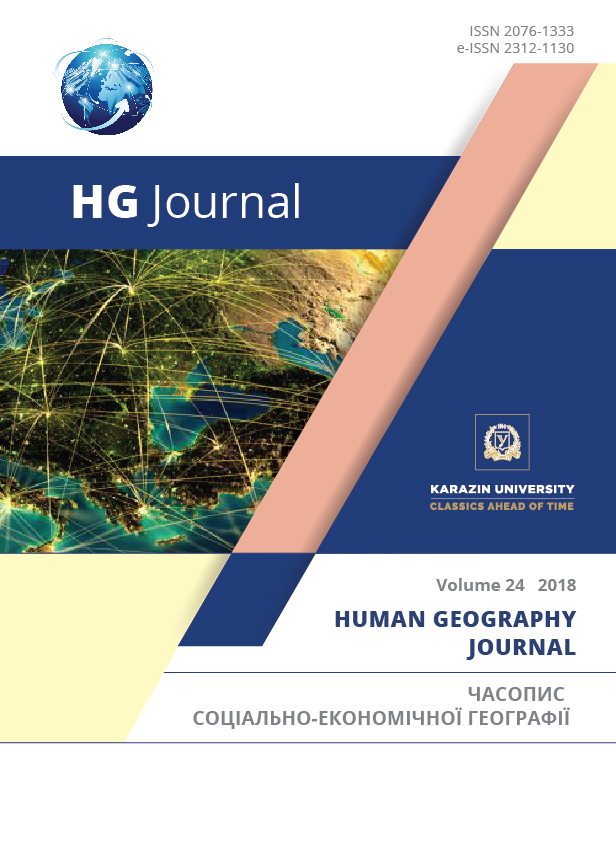Система розселення регіону як основа формування полюсів росту (на прикладі Харківської області)
Анотація
У статті розглянуто систему розселення регіону у якості основи формування полюсів росту на прикладі Харківської області. Проведено аналіз наукового доробку у сфері «центр-периферійних» теорій, теорії «центральних місць» та вивчення опорного каркасу розселення. Наведено ретроспективний аналіз дослідження в світовій науці міст та міського простору. Розкрито просторово-часові аспекти формування сучасної системи міського розселення Харківської області. За теорією інтегральних систем розселення виявлено різнорангові організаційні ядра системи розселення населення Харківської області. Визначено проблеми та перспективи еволюції системи розселення Харківської області.
Завантаження
Посилання
Bunge, V. (1967). Tsentralnye mesta v svete teorii i nablyudeniy [Central places in the light of theory and observations.]. Moscow, 149-163 [in Russian].
Vazhenin, A.A. (1977). Evolyutsionnye protsessy v sistemakh rasseleniya [Evolution processes in settlement systems]. Ekaterinburg, 59 [in Russian].
Golikov, A.P., Kazakova, N.A., Shuba, M.V. (2012). Kharkovskaya oblast. Regionalnoe razvitie: sostoyanie i perspektivy [Kharkov region. Regional development: state and prospects]. Kharkiv, KhNU, 223 [in Russian].
Lappo, G.M. (1997). Geografiya gorodov [Geography of cities]. Moscow, 481 [in Russian].
Ljosh, A. (2007). Prostranstvennaya organizatsiya khozyaystva [The spatial organization of the economy]. Moscow, 664 [in Russian].
Marunyak, Ye.O. (2016). Sotsialno-ekonomichnyi prostir (metodologiya geoprostorovykh doslidzhen ta praktyka planuvannya) [Socio-economic space (methodology of geospatial research and planning practice)]. Doctor’s thesis. Kyiv, 503 [in Ukrainian].
Pylypenko, I.O. (2015). Tsentro-peryferiyni protsesy i struktury v terytorialniy organizatsii suspilstva [Center-peripheral processes and structures in the territorial organization of society]. Doctor’s thesis. Kherson, 304 [in Ukrainian].
Podgrushnyi, G.P. (2012). Polyusa sotsialno-ekonomicheskogo rosta: problemy formirovaniya i rol v regionalnom razvitii [The Pole of Socio-Economic Growth: Problems of Formation and Role in the Regional Development]. International Scientific and Practical Conference, Minsk, Belarus, 54-56 [in Russian].
Ridevskiy, G.V. (2016). Tipologiya gorodskih poseleniy i stadialnost urbanizatsii v Belarusi [Typology of Urban Settlements and Stagiality of Urbanization in Belarus]. Retrieved from http://elib.bsu.by/bitstream/123456789/152317/1/Rideuski.pdf [in Russian].
Ridevskiy, G.V. (2013). Tsentr-periferiynye protsessy v rasselenii naseleniya sovremennoy Belarusi [Center-peripheral processes in the resettlement of the population of modern Belarus]. Regionalnye issledovaniya – Regional Research, 2, 94-99 [in Russian].
Tennis, F. (2002). Obshchnost i obshchestvo: osnovnye ponyatiya chistoy sotsiologii [Community and Society: the basic concepts of pure sociology]. St. Petersburg: Vladimir Dal, 451 [in Russian].
Tojn, P., Njubi, P. (1971). Metody geograficheskikh issledovaniy [Methods of geographical research]. Ekonomicheskaya geografiya – Economical geography, 1, 271 [in Russian].
Tjunen, I. (1926). Izolirovannoe gosudarstvo [The isolated state]. Moscow, Izd-vo gazety «Ekonomicheskaya zhizn» - Publishing house of the newspaper «Economic life», 326 [in Russian].
Utopia. City of Sun. Collection. LitMir - e-library. Retrieved from https://www.litmir.me/br/?b=212882&p=10
Shabliy, O.I. (2003). Osnovy zahalnoi suspilnoi geografii [Fundamentals of general human geography]. Lviv: Vydavnychyi tsentr LNU im. Ivana Franka, 444 [in Ukrainian].
Shuper, V.A. (1990). Nekotorye udivitelnye svoystva kristallerovskikh reshetok [Some surprising properties of crystal lattices]. Izvestiya RAN. Geogr. seriya, 1, 96-100 [in Russian].
Amin, A., Thrift, N. (2002). Cities: Reimagining the Urban. Cambridge: Polity Press, 196 [in English].
Boudeville, J. (1966). Problems of Regional Economic Planning. Edinburg, 11 [in English].
Burgess, E.W., Park, R.E., McKenzie, R.D. (1925). The Growth of the City: An Introduction to a Research Project. The City. Chicago: The University of Chicago Press, 47-62 [in English].
Christaller, W. (1967). Central Places in Southern Germany. New York: Englewood Cliffs, 230 [in English].
Friedmann, J. (1966). Regional Development Policy: A Case Study of Venezuela. Hardcover: MIT Press, 279 [in English].
Friedmann, J. (1979). Territory and Function: The evolution of regional planning. London: Edward Arnold, 355 [in English].
Hagerctrandt, T. (1968). Innovation diffusion as a spatial process. Chicago: University of Chicago Press, 350 [in English].
Harris, C.D., Ullman, E.L. (1945). The Nature of Cities. Annals of the American Academy of Political and Social Sciences, 24, 7-17 [in English].
Isard, W. (1956). Location and Space-Economy A General Theory Relating to Industrial Location, Market Areas, Land Use, Trade, and Urban Structure. New York: The Technology Press of M. I. T. and John Wiley and Sons, Inc., 380 [in English].
Isard, W. (1960). Methods of Regional Analysis: An Introduction to Regional Science Hardcover. Cambridge, Massachusetts, 784 [in English].
Lalanne, L. (1863). Essai d’une theorie des reseaux de chemin de fer, fondee sur l’observation des faits et ser les lois primordiales qui president au groupements des populations [Test of a theory of railway networks, based on the observation of the facts and the essential laws that preside over the groupings of the populations]. Comptes Rendus hebdomadaires des séances de l’Academie des Sciences, 57, 4, 206-210 [in French].
Perroux, F. (1991). L'Économie du XXe siècle [The economy of the 20th century]. Grenoble: Presses universitaires de Grenoble, 814 [in French].
Rydzeuski, H., Shadrakou, A. (2015). Typology and development of urban settlements in Belarus in 1959-2015 / Proceedings of the VIII International Academic Congress «Applied and Fundamental Studies in Eurasia, Africa and America» (South Africa, Cape Town, 18-20 June 2015). «UCT Press», 210-222 [in English].
Wallerstein, I. (2011). The Modern World-System: capitalist agriculture and the origins of the European world-economy in the sixteenth century. California : University of California Press, 440 [in English].
Авторське право (c) 2018 Niemets K., Kravchenko K., Mazurova A., Sehida K., Lurie A.

Цю роботу ліцензовано за Міжнародня ліцензія Creative Commons Attribution 4.0.




